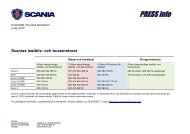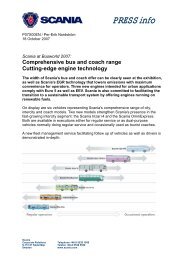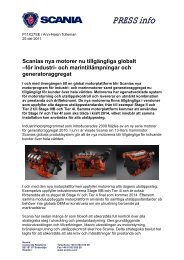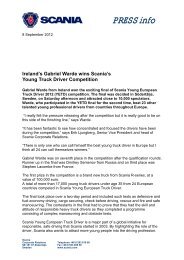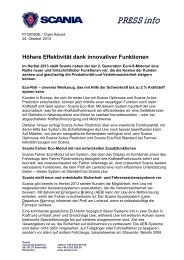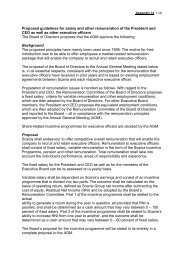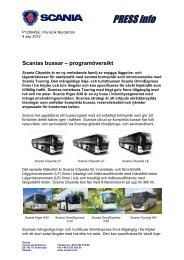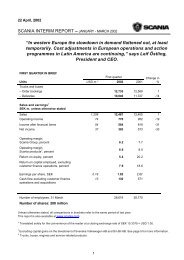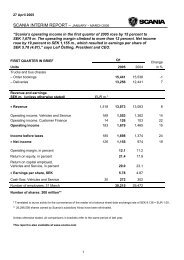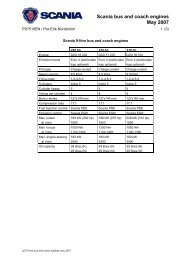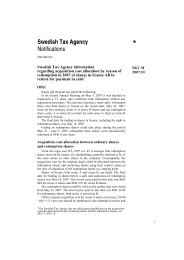Scania Annual Report 2011
Scania Annual Report 2011
Scania Annual Report 2011
You also want an ePaper? Increase the reach of your titles
YUMPU automatically turns print PDFs into web optimized ePapers that Google loves.
89<br />
Recognition of financial assets and liabilities<br />
Financial assets and liabilities are recognised in the balance sheet<br />
when the company becomes a party to their contractual terms and<br />
conditions. Receivables are recognised in the balance sheet when<br />
<strong>Scania</strong> has a contractual right to receive payment. Liabilities are recognised<br />
when the counterparty has performed and there is a contractual<br />
obligation to pay. A financial asset or a portion of a financial asset<br />
is derecognised from the balance sheet when the rights in the contract<br />
have been realised, expire or the company loses control over them. A<br />
financial liability or a portion of a financial liability is derecognised from<br />
the balance sheet when the obligation in the contract has been fulfilled<br />
or annulled or has expired. <strong>Scania</strong> applies settlement date accounting<br />
for everything except assets held for trading, where recognition occurs<br />
on the transaction date. Derivatives with positive values (unrealised<br />
gains) are recognised as “Other current receivables” or “Other noncurrent<br />
receivables”, while derivatives with negative values (unrealised<br />
losses) are recognised as “Other current liabilities” or “Other noncurrent<br />
liabilities”.<br />
Classification of financial instruments<br />
All financial assets and liabilities are classified in the following categories:<br />
a) Financial assets and financial liabilities carried at fair value via the<br />
income statement consist of two sub-categories:<br />
i) Financial assets and financial liabilities held for trading, which<br />
includes all of <strong>Scania</strong>’s derivatives aside from those derivatives<br />
that are used as hedging instruments when hedge accounting<br />
is applied. The main purpose of <strong>Scania</strong>’s derivative trading is to<br />
hedge the Group’s currency and interest rate risks.<br />
ii) Financial assets and financial liabilities that were determined from<br />
the beginning to belong to this category. <strong>Scania</strong> has no financial<br />
instruments classified in this sub-category.<br />
b) Held-to-maturity investments<br />
This category includes financial assets with predetermined or<br />
determinable payments and predetermined maturity that <strong>Scania</strong><br />
has the intention and ability to hold until maturity. <strong>Scania</strong> has no<br />
financial instruments classified in this category.<br />
c) Loan receivables and trade receivables<br />
These assets have predetermined or determinable payments.<br />
<strong>Scania</strong>’s cash and cash equivalents, trade receivables and loan<br />
receivables belong to this category.<br />
d) Financial assets which are available for sale<br />
This category consists of financial assets that have not been classified<br />
in any other category, such as shares and participations in both<br />
listed and unlisted companies. <strong>Scania</strong> has no financial instruments<br />
classified in this category.<br />
e) Other financial liabilities<br />
Includes financial liabilities not held for trading. <strong>Scania</strong>’s trade<br />
payables as well as borrowings belong to this category.<br />
Recognition and carrying amounts<br />
Financial assets and liabilities are initially recognised at their cost,<br />
which is equivalent to their fair value at that time. Financial assets and<br />
liabilities in foreign currencies are translated to Swedish kronor, taking<br />
into account the closing day exchange rate.<br />
Below are the main accounting principles that <strong>Scania</strong> applies to<br />
financial assets and financial liabilities.<br />
Exceptions from these principles apply to financial instruments<br />
included in hedging relationships. A more thorough description is<br />
provided for exceptions to the principles in the “Hedge accounting”<br />
section.<br />
a) Financial assets and liabilities carried at fair value via the income<br />
statement are continuously carried at fair value. Changes in the<br />
value of derivatives that hedge forecasted future payment flows<br />
(sales) are recognised in the income statement. Changes in the<br />
value of derivatives that are used to convert borrowings to a<br />
desired currency or to a desired interest rate refixing structure<br />
are recognised in net financial items.<br />
b) Held-to-maturity investments are carried in the balance sheet at<br />
accrued cost. Interest income is recognised in net financial items.<br />
<strong>Scania</strong> has no financial instruments classified in this category.<br />
c) Loan receivables and trade receivables are carried in the balance<br />
sheet at accrued cost minus potential bad debt losses. Provision s<br />
for probable bad debt losses/doubtful receivables are made<br />
followin g an individual assessment of each customer, based on<br />
the customer’s payment capacity, expected future risk and the<br />
value of collateral received. In addition to the individual assessment,<br />
provisions are made for potential bad debt losses based on a<br />
collective assessment of the assets.<br />
d) Financial assets available for sale are carried continuously at fair<br />
value, with changes in value recognised under “Other comprehensive<br />
income” and accumulated in the fair value reserve in equity.<br />
On the date that the assets are derecognised from the balance<br />
sheet, any previously recognised accumulated gain or loss in equity<br />
is transferred to the income statement. <strong>Scania</strong> has no financial<br />
instruments classified in this category.<br />
e) Other financial liabilities are initially recognised at market value,<br />
which is equivalent to the amount received on that date less any<br />
transaction costs, and later at accrued cost. Premiums or discounts<br />
upon issuance of securities are accrued over the life of the loan<br />
by using the effective interest method and are recognised in net<br />
financial items.<br />
Any gains that arise in conjunction with the divestment of financial<br />
instruments or redemption of loan liabilities are recognised in the<br />
income statement.<br />
financial reports <strong>Scania</strong> <strong>2011</strong>



